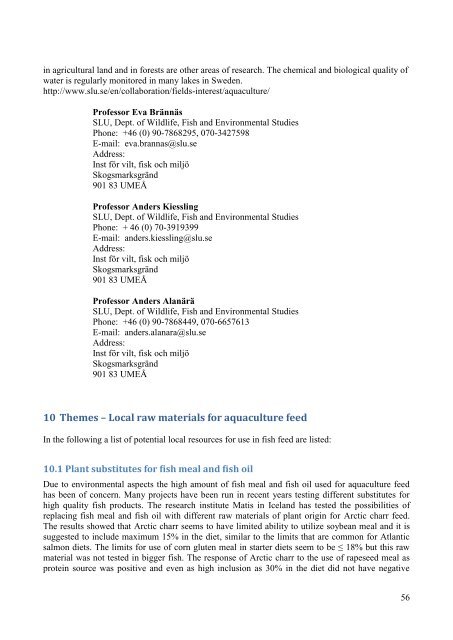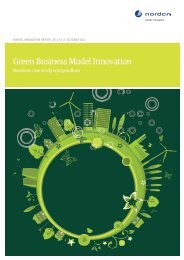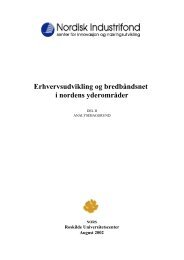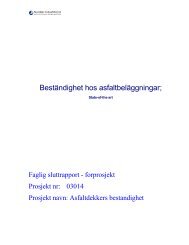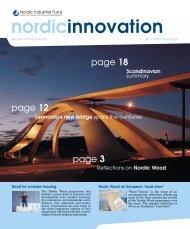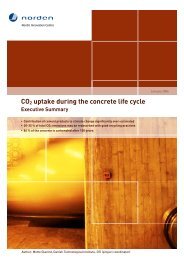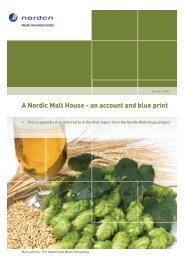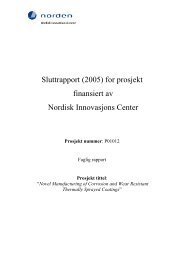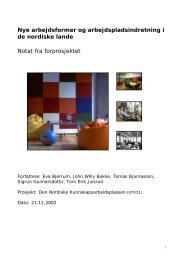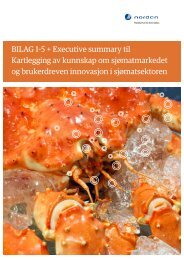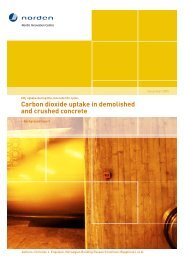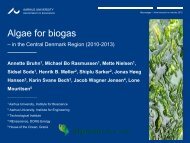Local raw materials for production of fish feed for ... - Nordic Innovation
Local raw materials for production of fish feed for ... - Nordic Innovation
Local raw materials for production of fish feed for ... - Nordic Innovation
You also want an ePaper? Increase the reach of your titles
YUMPU automatically turns print PDFs into web optimized ePapers that Google loves.
in agricultural land and in <strong>for</strong>ests are other areas <strong>of</strong> research. The chemical and biological quality <strong>of</strong><br />
water is regularly monitored in many lakes in Sweden.<br />
http://www.slu.se/en/collaboration/fields-interest/aquaculture/<br />
Pr<strong>of</strong>essor Eva Brännäs<br />
SLU, Dept. <strong>of</strong> Wildlife, Fish and Environmental Studies<br />
Phone: +46 (0) 90-7868295, 070-3427598<br />
E-mail: eva.brannas@slu.se<br />
Address:<br />
Inst för vilt, fisk och miljö<br />
Skogsmarksgränd<br />
901 83 UMEÅ<br />
Pr<strong>of</strong>essor Anders Kiessling<br />
SLU, Dept. <strong>of</strong> Wildlife, Fish and Environmental Studies<br />
Phone: + 46 (0) 70-3919399<br />
E-mail: anders.kiessling@slu.se<br />
Address:<br />
Inst för vilt, fisk och miljö<br />
Skogsmarksgränd<br />
901 83 UMEÅ<br />
Pr<strong>of</strong>essor Anders Alanärä<br />
SLU, Dept. <strong>of</strong> Wildlife, Fish and Environmental Studies<br />
Phone: +46 (0) 90-7868449, 070-6657613<br />
E-mail: anders.alanara@slu.se<br />
Address:<br />
Inst för vilt, fisk och miljö<br />
Skogsmarksgränd<br />
901 83 UMEÅ<br />
10 Themes – <strong>Local</strong> <strong>raw</strong> <strong>materials</strong> <strong>for</strong> aquaculture <strong>feed</strong><br />
In the following a list <strong>of</strong> potential local resources <strong>for</strong> use in <strong>fish</strong> <strong>feed</strong> are listed:<br />
10.1 Plant substitutes <strong>for</strong> <strong>fish</strong> meal and <strong>fish</strong> oil<br />
Due to environmental aspects the high amount <strong>of</strong> <strong>fish</strong> meal and <strong>fish</strong> oil used <strong>for</strong> aquaculture <strong>feed</strong><br />
has been <strong>of</strong> concern. Many projects have been run in recent years testing different substitutes <strong>for</strong><br />
high quality <strong>fish</strong> products. The research institute Matis in Iceland has tested the possibilities <strong>of</strong><br />
replacing <strong>fish</strong> meal and <strong>fish</strong> oil with different <strong>raw</strong> <strong>materials</strong> <strong>of</strong> plant origin <strong>for</strong> Arctic charr <strong>feed</strong>.<br />
The results showed that Arctic charr seems to have limited ability to utilize soybean meal and it is<br />
suggested to include maximum 15% in the diet, similar to the limits that are common <strong>for</strong> Atlantic<br />
salmon diets. The limits <strong>for</strong> use <strong>of</strong> corn gluten meal in starter diets seem to be ≤ 18% but this <strong>raw</strong><br />
material was not tested in bigger <strong>fish</strong>. The response <strong>of</strong> Arctic charr to the use <strong>of</strong> rapeseed meal as<br />
protein source was positive and even as high inclusion as 30% in the diet did not have negative<br />
56


